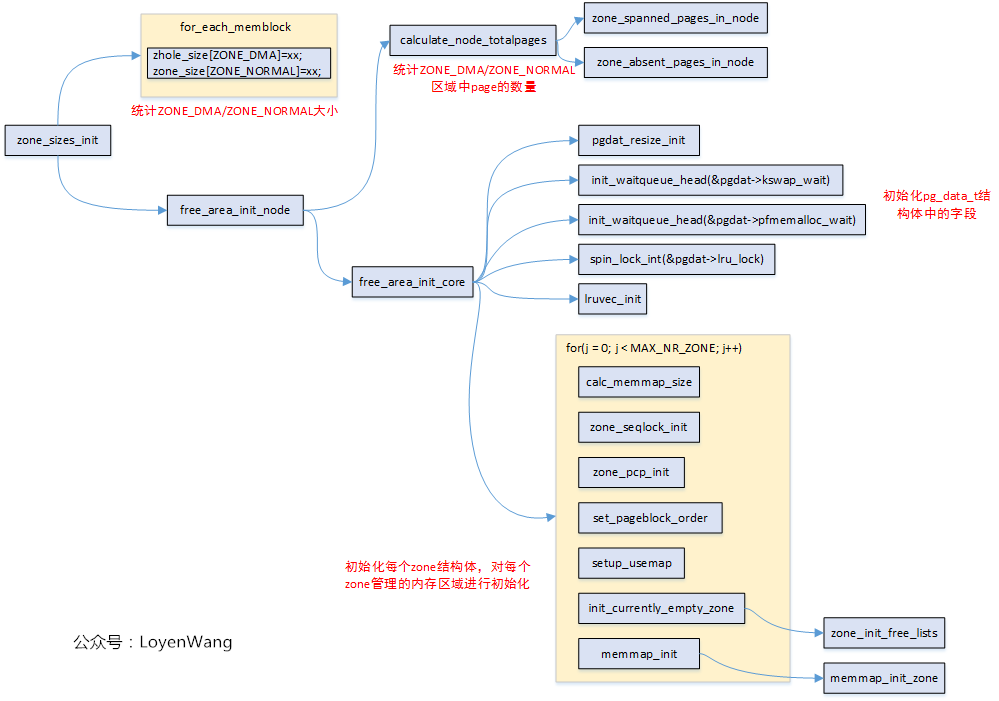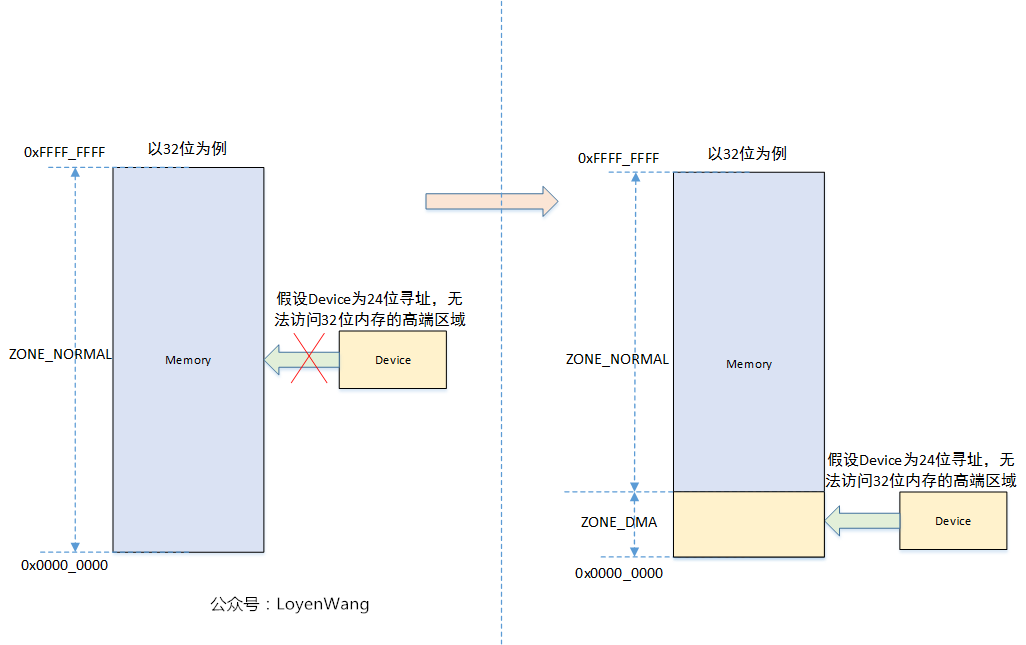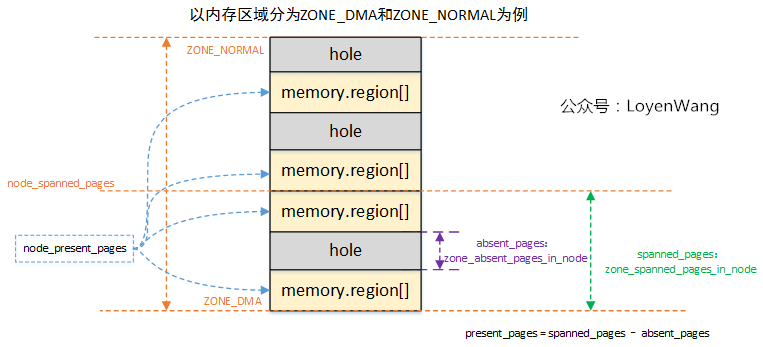【原創】(五)Linux內存管理zone_sizes_init
- 2019 年 10 月 3 日
- 筆記
背景
Read the fucking source code!–By 魯迅A picture is worth a thousand words.–By 高爾基
說明:
- Kernel版本:4.14
- ARM64處理器,Contex-A53,雙核
- 使用工具:Source Insight 3.5, Visio
1. 介紹
在(四)Linux內存模型之Sparse Memory Model中,我們分析了bootmem_init函數的上半部分,這次讓我們來到下半部分吧,下半部分主要是圍繞zone_sizes_init函數展開。
前景回顧:
bootmem_init()函數代碼如下:
void __init bootmem_init(void) { unsigned long min, max; min = PFN_UP(memblock_start_of_DRAM()); max = PFN_DOWN(memblock_end_of_DRAM()); early_memtest(min << PAGE_SHIFT, max << PAGE_SHIFT); max_pfn = max_low_pfn = max; arm64_numa_init(); /* * Sparsemem tries to allocate bootmem in memory_present(), so must be * done after the fixed reservations. */ arm64_memory_present(); sparse_init(); zone_sizes_init(min, max); memblock_dump_all(); }在Linux中,物理內存地址區域採用zone來管理。不打算來太多前戲了,先上一張zone_sizes_init的函數調用圖吧:

需要再說明一點是,使用的是ARM64,UMA(只有一個Node),此外,流程分析中那些沒有打開的宏,相應的函數就不深入分析了。開始探索吧!
2. 數據結構

關鍵的結構體如上圖所示。
在NUMA架構下,每一個Node都會對應一個struct pglist_data,在UMA架構中只會使用唯一的一個struct pglist_data結構,比如我們在ARM64 UMA中使用的全局變量struct pglist_data __refdata contig_page_data。
struct pglist_data 關鍵字段
struct zone node_zones[]; //對應的ZONE區域,比如ZONE_DMA,ZONE_NORMAL等 struct zonelist_node_zonelists[]; unsigned long node_start_pfn; //節點的起始內存頁面幀號 unsigned long node_present_pages; //總共可用的頁面數 unsigned long node_spanned_pages; //總共的頁面數,包括有空洞的區域 wait_queue_head_t kswapd_wait; //頁面回收進程使用的等待隊列 struct task_struct *kswapd; //頁面回收進程
struct zone 關鍵字段
unsigned long watermark[]; //水位值,WMARK_MIN/WMARK_LOV/WMARK_HIGH,頁面分配器和kswapd頁面回收中會用到 long lowmem_reserved[]; //zone中預留的內存 struct pglist_data *zone_pgdat; //執行所屬的pglist_data struct per_cpu_pageset *pageset; //Per-CPU上的頁面,減少自旋鎖的爭用 unsigned long zone_start_pfn; //ZONE的起始內存頁面幀號 unsigned long managed_pages; //被Buddy System管理的頁面數量 unsigned long spanned_pages; //ZONE中總共的頁面數,包含空洞的區域 unsigned long present_pages; //ZONE里實際管理的頁面數量 struct frea_area free_area[]; //管理空閑頁面的列表宏觀點的描述:struct pglist_data描述單個Node的內存(UMA架構中的所有內存),然後內存又分成不同的zone區域,zone描述區域內的不同頁面,包括空閑頁面,Buddy System管理的頁面等。

3. zone
上個代碼吧:
enum zone_type { #ifdef CONFIG_ZONE_DMA /* * ZONE_DMA is used when there are devices that are not able * to do DMA to all of addressable memory (ZONE_NORMAL). Then we * carve out the portion of memory that is needed for these devices. * The range is arch specific. * * Some examples * * Architecture Limit * --------------------------- * parisc, ia64, sparc <4G * s390 <2G * arm Various * alpha Unlimited or 0-16MB. * * i386, x86_64 and multiple other arches * <16M. */ ZONE_DMA, #endif #ifdef CONFIG_ZONE_DMA32 /* * x86_64 needs two ZONE_DMAs because it supports devices that are * only able to do DMA to the lower 16M but also 32 bit devices that * can only do DMA areas below 4G. */ ZONE_DMA32, #endif /* * Normal addressable memory is in ZONE_NORMAL. DMA operations can be * performed on pages in ZONE_NORMAL if the DMA devices support * transfers to all addressable memory. */ ZONE_NORMAL, #ifdef CONFIG_HIGHMEM /* * A memory area that is only addressable by the kernel through * mapping portions into its own address space. This is for example * used by i386 to allow the kernel to address the memory beyond * 900MB. The kernel will set up special mappings (page * table entries on i386) for each page that the kernel needs to * access. */ ZONE_HIGHMEM, #endif ZONE_MOVABLE, #ifdef CONFIG_ZONE_DEVICE ZONE_DEVICE, #endif __MAX_NR_ZONES };通用內存管理要應對各種不同的架構,X86,ARM,MIPS…,為了減少複雜度,只需要挑自己架構相關的。目前我使用的平台,只配置了ZONE_DMA和ZONE_NORMAL。Log輸出如下圖:

為什麼沒有ZONE_NORMAL區域內,跟蹤一通代碼發現,ZONE_DMA區域設置的大小是從起始內存開始的4G區域並且不能超過4G邊界區域,而我使用的內存為512M,所以都在這個區域內了。
從上述結構體中可以看到,ZONE_DMA是由宏定義的,ZONE_NORMAL才是所有架構都有的區域,那麼為什麼需要一個ZONE_DMA區域內,來張圖:

所以,如果所有設備的尋址範圍都是在內存的區域內的話,那麼一個ZONE_NORMAL是夠用的。
4. calculate_node_totalpages
這個從名字看就很容易知道是為了統計Node中的頁面數,一張圖片解釋所有:

- 前邊的文章分析過,物理內存由
memblock維護,整個內存區域,是有可能存在空洞區域,也就是圖中的hole部分; - 針對每個類型的
ZONE區域,分別會去統計跨越的page frame,以及可能存在的空洞,並計算實際可用的頁面present_pages; Node管理各個ZONE,它的spanned_pages和present_pages是統計各個ZONE相應頁面之和。
這個過程計算完,基本就把頁框的信息納入管理了。
5. free_area_init_core
簡單來說,free_area_init_core函數主要完成struct pglist_data結構中的字段初始化,並初始化它所管理的各個zone,看一下代碼吧:
/* * Set up the zone data structures: * - mark all pages reserved * - mark all memory queues empty * - clear the memory bitmaps * * NOTE: pgdat should get zeroed by caller. */ static void __paginginit free_area_init_core(struct pglist_data *pgdat) { enum zone_type j; int nid = pgdat->node_id; pgdat_resize_init(pgdat); #ifdef CONFIG_NUMA_BALANCING spin_lock_init(&pgdat->numabalancing_migrate_lock); pgdat->numabalancing_migrate_nr_pages = 0; pgdat->numabalancing_migrate_next_window = jiffies; #endif #ifdef CONFIG_TRANSPARENT_HUGEPAGE spin_lock_init(&pgdat->split_queue_lock); INIT_LIST_HEAD(&pgdat->split_queue); pgdat->split_queue_len = 0; #endif init_waitqueue_head(&pgdat->kswapd_wait); init_waitqueue_head(&pgdat->pfmemalloc_wait); #ifdef CONFIG_COMPACTION init_waitqueue_head(&pgdat->kcompactd_wait); #endif pgdat_page_ext_init(pgdat); spin_lock_init(&pgdat->lru_lock); lruvec_init(node_lruvec(pgdat)); pgdat->per_cpu_nodestats = &boot_nodestats; for (j = 0; j < MAX_NR_ZONES; j++) { struct zone *zone = pgdat->node_zones + j; unsigned long size, realsize, freesize, memmap_pages; unsigned long zone_start_pfn = zone->zone_start_pfn; size = zone->spanned_pages; realsize = freesize = zone->present_pages; /* * Adjust freesize so that it accounts for how much memory * is used by this zone for memmap. This affects the watermark * and per-cpu initialisations */ memmap_pages = calc_memmap_size(size, realsize); if (!is_highmem_idx(j)) { if (freesize >= memmap_pages) { freesize -= memmap_pages; if (memmap_pages) printk(KERN_DEBUG " %s zone: %lu pages used for memmapn", zone_names[j], memmap_pages); } else pr_warn(" %s zone: %lu pages exceeds freesize %lun", zone_names[j], memmap_pages, freesize); } /* Account for reserved pages */ if (j == 0 && freesize > dma_reserve) { freesize -= dma_reserve; printk(KERN_DEBUG " %s zone: %lu pages reservedn", zone_names[0], dma_reserve); } if (!is_highmem_idx(j)) nr_kernel_pages += freesize; /* Charge for highmem memmap if there are enough kernel pages */ else if (nr_kernel_pages > memmap_pages * 2) nr_kernel_pages -= memmap_pages; nr_all_pages += freesize; /* * Set an approximate value for lowmem here, it will be adjusted * when the bootmem allocator frees pages into the buddy system. * And all highmem pages will be managed by the buddy system. */ zone->managed_pages = is_highmem_idx(j) ? realsize : freesize; #ifdef CONFIG_NUMA zone->node = nid; #endif zone->name = zone_names[j]; zone->zone_pgdat = pgdat; spin_lock_init(&zone->lock); zone_seqlock_init(zone); zone_pcp_init(zone); if (!size) continue; set_pageblock_order(); setup_usemap(pgdat, zone, zone_start_pfn, size); init_currently_empty_zone(zone, zone_start_pfn, size); memmap_init(size, nid, j, zone_start_pfn); } }- 初始化
struct pglist_data內部使用的鎖和隊列;
遍歷各個zone區域,進行如下初始化:
-
根據
zone的spanned_pages和present_pages,調用calc_memmap_size計算管理該zone所需的struct page結構所佔的頁面數memmap_pages; -
zone中的freesize表示可用的區域,需要減去memmap_pages和DMA_RESERVE的區域,如下圖在開發板的Log打印所示:memmap使用2048頁,DMA保留0頁;

-
計算
nr_kernel_pages和nr_all_pages的數量,為了說明這兩個參數和頁面的關係,來一張圖(由於我使用的平台只有一個ZONE_DMA區域,且ARM64沒有ZONE_HIGHMEM區域,不具備典型性,故以ARM32為例):

-
初始化
zone使用的各類鎖; -
分配和初始化
usemap,初始化Buddy System中使用的free_area[],lruvec,pcp等; -
memmap_init()->memmap_init_zone(),該函數主要是根據PFN,通過pfn_to_page找到對應的struct page結構,並將該結構進行初始化處理,並設置MIGRATE_MOVABLE標誌,表明可移動;
最後,當我們回顧bootmem_init函數時,發現它基本上完成了linux物理內存框架的初始化,包括Node, Zone, Page Frame,以及對應的數據結構等。
結合上篇文章(四)Linux內存模型之Sparse Memory Model閱讀,效果會更佳噢!
持續中…

